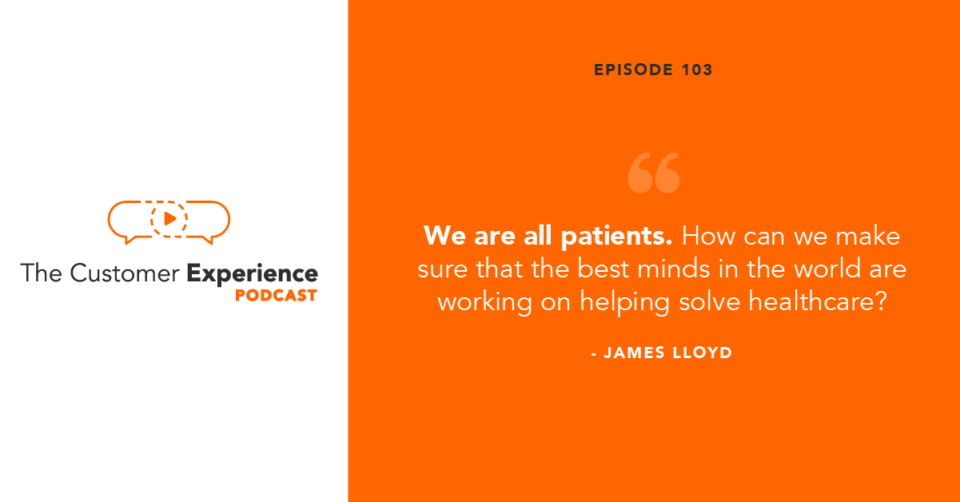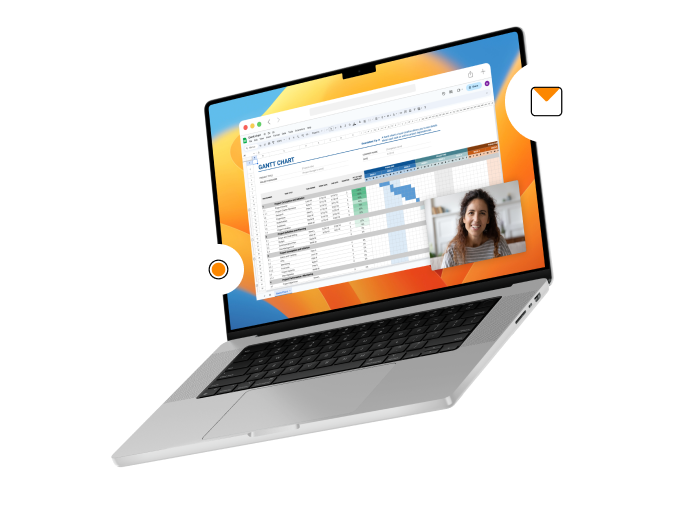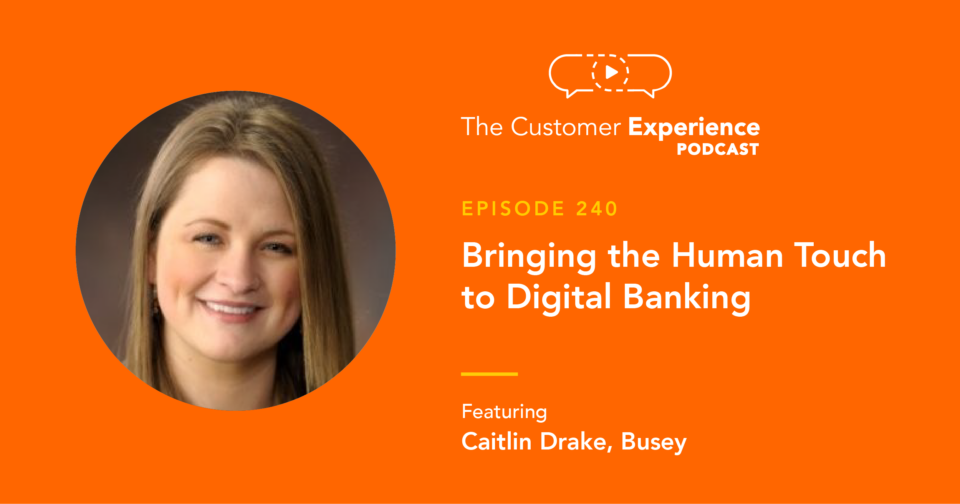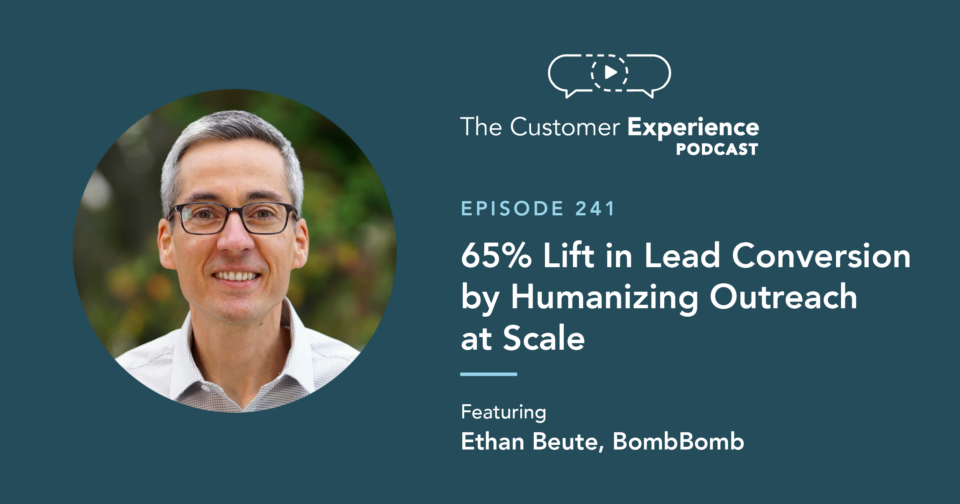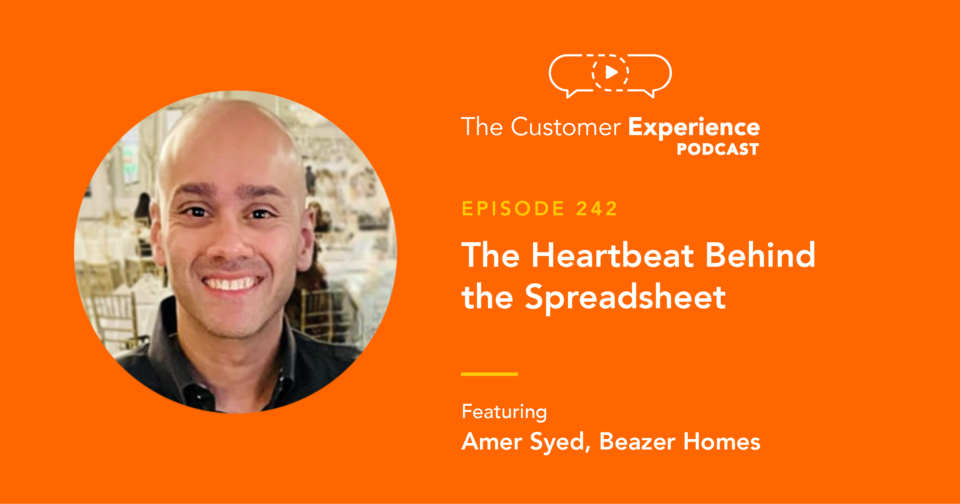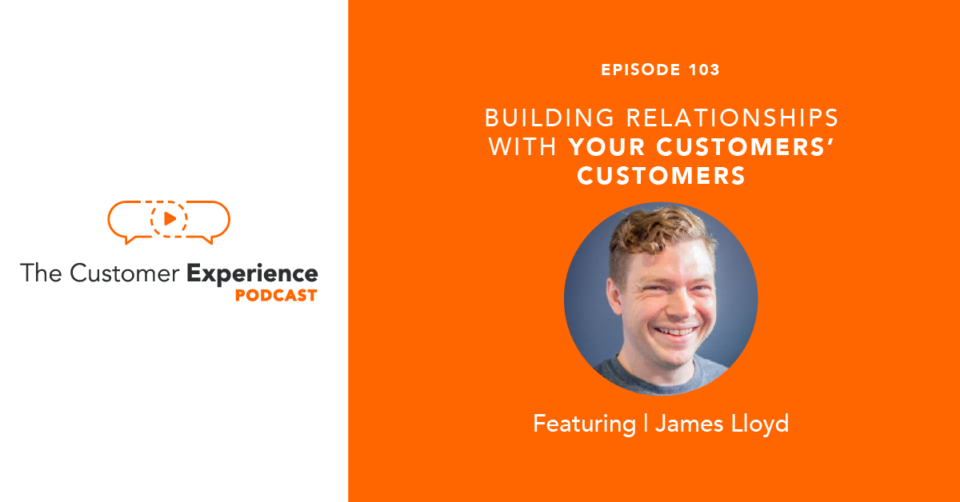
Listen to “103. Building Relationships With Your Customers’ Customers w/ James Lloyd” on Spreaker.
Apple Podcasts | Google Podcasts | Stitcher | Spotify
If your company is, say, a data and technology platform in the healthcare space, you can’t solely focus on healthcare tech vendors as your customers. You also have to focus on your customers’ customers. In this case, health systems.
While some of your customers in one segment have grown extensively in one month, some of your customers in the other segment have had their entire information technology department furloughed. The problems, opportunities, desired outcomes, and ideal customer experiences are myriad.
You must build relationships and provide customer experiences that serve both your customers and their customers.
Our guest on this episode of The Customer Experience Podcast, James Lloyd, cofounded his company six years ago. But it didn’t look anything like it does today.
In working directly with healthcare software vendors, he also builds relationships with those vendors’ customers, which are health systems. It’s a flywheel model designed to help both the vendors and the health systems thrive.
James Lloyd is cofounder and Chief Technology Officer at Redox, a data and technology platform in the healthcare industry. His company’s goal is to carry the burden of building a product in healthcare so that vendors can focus on their end-users without worrying about healthcare complexities.
Fun fact: he’s the first CTO we’ve had on the podcast!
Throughout our conversation, we discuss…
• How to manage multiple customer experiences
• What healthcare can learn from other markets and vice versa
• How engineering differs from sales and marketing
• What the Cynefin framework is
Building Relationships With Your Customers’ Customers
Hear the entire conversation with James Lloyd of Redox right here:
Listen to “103. Building Relationships With Your Customers’ Customers w/ James Lloyd” on Spreaker.
Hear this episode of The Customer Experience Podcast (and any or all of the others!) by subscribing:
Check out the podcast in your preferred player by clicking one of the links above. Then, gives another click once you’re there to leave a rating – it’s extremely helpful to the show.
Sign up for a monthly email with CX insights and highlights
By entering your email, you are agreeing to receive occasional BombBomb news & communication. We will never sell or distribute your email address to any 3rd party. You can manage your communication preferences here.
View our Privacy Policy.

Full Transcript: Using Suggestion to Sell Decisions and Good Feelings
Ethan Beute:
Managing multiple customer experiences, designing a buyer’s journey for tech tools and infrastructure, adapting key technologies, and building team resilience during and post-pandemic. That’s some of what we’ll walk through today with a gentleman who holds three bachelor’s degrees. One in German, one in mathematics, and one in physics. He’s the co-founder and chief technology officer at Redox Engine, the modern API for healthcare or per their homepage right now, the simplest way for vendors and provider organizations to exchange health data. James Lloyd, welcome to the Customer Experience podcast.
James Lloyd:
Yeah. Thanks so much for having me.
Ethan Beute:
Yeah. So you recently moved from, was it Madison, Wisconsin to Denver?
James Lloyd:
Yeah.
Ethan Beute:
Compared to your expectations, six months in, what is better about Denver than you expected, and what is maybe surprising or perhaps even disappointing relative to your expectations?
James Lloyd:
So the thing that’s better is I really, as a visitor, you don’t quite get to value the proximity to the mountains of just like an everyday type of experience and so I’ve been loving the access to nature and the weather that we have here. And then what’s surprising is just everything that comes with living in a slightly larger city. I think I’m pretty much right downtown in Denver. And Madison is basically a college town of a few hundred thousand people and yeah, so there’s lots of interesting things going on all the time. Some awesome. Some less awesome. And yeah, so just the lifestyle of being in a larger city has been one of the surprises for sure.
Ethan Beute:
Cool. On the upside, traffic is probably amazing right now, relative to when you moved here on. The downside, that will ramp up while everything gets even more interesting and dynamic. You’re in a great spot. It’s fantastic. And I hope when it’s more safe and fun and cool to spend time with people in person, I’ll come up and see you.
James Lloyd:
Yeah. Sound good.
Ethan Beute:
Yeah. So you are the first CTO on the show and I’m really excited to have a customer experience conversation with a co-founder and CTO, not that that’s exclusively what defines you. But so to get started, when I say customer experience to you, what does that mean? What does it conjure?
James Lloyd:
Yeah. So for me, the customer experience really starts with the upfront expectations and desires of the folks who may have a problem and that they’re looking to solve. And then all the way through the experience of leveraging our products and our platform and ensuring that their lives get a little bit easier and that we can have an impact in the world as well.
James Lloyd:
So maybe a little bit of something that’s kind of interesting about Redox is we view ourselves as a platform where our users are typically software developers. But when we think about customers overall, we think about the companies that are creating technology in health care, as well as the patients that are involved in receiving care, as well as the organizations and providers who are servicing and providing that care. So we have, independent of who may be paying us, we view our kind of ecosystem as involving lots of customers who all have an experience that we’re trying to drive.
Ethan Beute:
That’s awesome. I love the problem orientation in particular that you introduced. I don’t think there’s enough conversation about that. Although, you hear it in pockets and I appreciate in particular, the idea that you are taking into account kind of the customers of your direct customers and including them as obviously fellow stakeholders in the problem, solution, dynamic that you’re in with your customers, not to say customers too many times there. And you already, you already took one step toward it, but go ahead and lean into it further. For people who aren’t familiar, tell us a little bit more about Redox, like who is your ideal customer or customers, and what problem do you solve for them?
James Lloyd:
Absolutely. So Redox is a data and technology platform in the healthcare space and we really help technology vendors get their services and technology in the hands of patients and providers in as lightweight and low friction way as possible. And one of the things that’s kind of interesting about healthcare, I’m sure many of the listeners have maybe unfortunately run across some of these problems as patients, but the healthcare world and especially the data world within healthcare is, is fairly fragmented. Every hospital, every health system runs their own data centers, highly customized, highly bespoke, and antiquated infrastructure and systems in play. And as a technology vendor in this space, if you want to scale your products to many customers, which would be many hospitals or health systems, managing all of those complexities and all of that bespoke nature of each of the systems can be really challenging.
James Lloyd:
And so, one of the ways that we help reduce that friction is by providing a single API and developer experience for the technology vendors, so they can connect to our platform once. And then we have a robust network and way to kind of standardize all of those different instances of all the different health systems.
James Lloyd:
So we work with about 800 or so health systems today, which roughly equates to about 20% to 25% of the overall kind of US landscape. And we have about 300 or so software vendors that are customers of ours and they range everywhere from 10 person company to fortune 100 type companies. And yeah, so those are kind of who we typically work with.
James Lloyd:
But in general, we really love working with folks who are making the world a better place for patients or providers and really delivering innovative technology to the healthcare landscape. And our goal is really to take on as much of the burden of building a product and healthcare so that the folks who are working at those vendors can really focus on their end-users and their value props and not have to worry about the complexities of just dealing with healthcare.
Ethan Beute:
It’s really interesting when, so the company is what, six and a half years old-ish?
James Lloyd:
Yeah. Around that. Yeah. We have an interesting starting story that probably, it depends on where you want to start.
Ethan Beute:
I would love a little bit of that. What I was going to ask specifically is, I mean, this is obviously a problem and it’s a very, very big one. So at the outset, how did you view the scene and what were some of the kind of like the primary motivators, like what were you running after at the time and has that evolved over time and has your view of the customer evolved over that time as well?
Ethan Beute:
So share anything you want on that, like go back to the beginning. What were you trying to do at the time and how has your perspective changed over the past six years or so? Because again, I really liked this idea of respecting your customer’s customers, because that is the true way to be a partner with your customer rather than just a vendor is to take on their problems, take on their opportunities and really help them serve their customers more effectively. I really appreciate that. What I’m wondering is, is that how you thought about a six and a half years ago?
James Lloyd:
Yeah, yeah, absolutely. So when we first got started, myself and the two other co-founders, we actually worked at a large electronic health record company. So this is the type of software that doctors and nurses are typing your allergies and diagnoses into, eight, 10 hours a day, and learned a lot about the environment and also the way that those folks were not being really well supported by biotechnology.
James Lloyd:
And at that point, a lot of the health healthcare technology industry looked a lot like the productivity space in say the early 2000s where you just got everything from Microsoft. You got outlook and Word and Access and Exchange Server and everything, like you just got it all bundled together. And as we saw the world going through the Gmail, and then you have targeted apps for each thing, and you use Asana and it connects to all the other tools and APIs. There was a sort of hypothesis that that kind of shift would also take place in healthcare because the demands that the providers and patients were having were evolving quicker than the kind of large monolithic software vendors could keep up with.
James Lloyd:
And so, our initial kind of first step into this was to actually start a healthcare technology accelerator. So we were trying to be part of helping proliferate all these new very targeted applications. And we did that for about a year before we realized that we could not figure out how to make any money running an accelerator, and we had to pay rent and buy food and stuff like that.
James Lloyd:
But through the process, we learned that we learned some of the challenges to scaling a company, and we started about 10 different companies, and so we saw all their challenges and one of the biggest areas was just how do we connect and share this information?
James Lloyd:
And so, as we were starting, the accelerator, we in the background were building a suite of technology for all those accelerator companies to use. And as we were kind of coming to a conclusion, we probably needed to just become a single company rather than running an accelerator. We were looking around and saying, should we just join one of these companies that we have in the accelerator or what, and then the idea of becoming actually the technology platform company, as the company itself, kind of went out because we already had a bit of product-market fit, because we were scratching our own itch and we had a bunch of mentors that we had built up in the accelerator and they all told us like, Oh yeah, this is a huge problem. You got to go solve it.
James Lloyd:
And so, from kind of day one, the idea was standardization will provide efficiency in a way that new entrants to the market will be okay with it. They’ll want to be told this is the right way to do it and there’s only one way to do it. And through that kind of standardization and building a network around that agreed upon and kind of canonical language, we can really unlock and really lower the barrier to entry to a lot of the integration space.
James Lloyd:
And then the other ideas was that this should be really, really simple to use. Like we want people who do not have a master’s in healthcare administration needed to be able to develop against their API. And healthcare has a ton of jargon and there’s a lot of actual complexity to it, right. It takes people 20 years to get an MD or something like that. So we’re trying to abstract and simplify as much as possible so that the folks who are building our platform can do it safely but also do it really easily.
Ethan Beute:
That’s cool. What are the disciplines of your two co-founders? Are they tech-oriented? Do you have just kind of a natural leader who loves software? Do you have like a sales? Like who are your co-founders in that stage?
James Lloyd:
Yeah. So all three of us are still really heavily engaged in the company today. So Luke is our CEO and he’s really engaged on the, I’d say like the finance operations kind of management and people side of the company. And then Nico is our other co-founder and he’s really externally-facing and market-oriented and has a background in economics. So he sort of is an interesting combination of both a really academically-oriented economist as well as sort of like the frontman of the band. And he used to do all the pitches and everything like that. And so these days, he runs our podcast actually and he also engages with government groups on upcoming standards regulation and does a lot of that kind of externally facing activity as well. So early on, we definitely all did every role, but those are sort of kind of where we focus today.
Ethan Beute:
Cool. It sounds like a really nice balance and congratulations on getting this far. It’s obviously a huge need and I think on behalf of people listening who don’t quite know all the guts behind their experience with medical providers, I’m sure they appreciate any of the friction you’ve removed.
Ethan Beute:
So let’s get into the kind of the buyer’s journey piece of it. You have a go-to-market and so I’m clear and so listeners are clear, are you primarily, like is your, for example, your sales team or sales and marketing, are they primarily going out to the other software companies or are they going out to the healthcare systems or both, and talk about like, again, kind of just generically speaking, buyer’s journey for technical tools and infrastructure.
James Lloyd:
Yeah, absolutely. Absolutely. So we’ve definitely had a number of experiments and lessons learned and kind of varieties of answers to this question, but what we do today and kind of our bread and butter is through engaging directly with the software vendors as that’s kind of who we’re … our go-to-market motion is really towards the software vendors. But we really think about it actually as kind of a flywheel and sort of really the first entry point is with bringing a new software vendor onto our platform. And so that’s where we market and do our sales. But we really think about it more as once that software vendors on our platform, they will then work with one of their customers, which will be a health system.
James Lloyd:
And as part of that, we will build a relationship with that health system as well. And then we’ll learn about some of their needs, some of their upcoming vendors that may be struggling or need our services and we can engage with them. And then those software vendors might bring us to other health systems. And so there’s sort of a feedback loop that can develop as part of that.
James Lloyd:
And so now when we think about account management or customer success, then it starts to get really pointed in both directions where we want to help folks scale and have their technology and business strategy align with what we’re seeing. And we have really aligned incentives with helping those vendors scale, but we also really want to work with the health systems to make sure that their initiatives for the year or whatever it may be, can be well-served by the groups that we work with and help them get those easily as well.
Ethan Beute:
Super interesting. I can see a scenario where you are partnered with a software vendor. They land a new health system, but I would guess that within your ecosystem, there are probably, that health system, might be using two or three other technologies that are part of your platform that they maybe didn’t know that they could connect them all.
James Lloyd:
That’s right. And this is where the benefit of this sort of network approach really takes hold is historically this would have been a dozens of hours project for someone at that health system each time and through what we do, there’s a decent amount of reusability and efficiency that comes from just kind of amortizing that initial work with the health system across all the different vendors that they could want to work with.
Ethan Beute:
Really interesting. I see immediate parallels with some of the partnership and integration work that we do here at BombBomb through our VP of partnerships and integrations, Rebecca Svoma. And this kind of, again, I mean, I don’t know, network effect, flywheel type thing, where now all of a sudden we are of more value to the customer. A, we get to meet our partner’s customers, and should they participate with both of us, we’re now more valuable to that customer than either one of us was individually. I see the benefits of it right away. I would assume that you have friends involved in a variety of other roles in businesses.
Ethan Beute:
What are some of the parallels here from the way that you’re approaching this in healthcare? Have you talked with other people? Just to kind of walk this out and make it even more mainstream to people working in a wide variety of businesses.
James Lloyd:
Absolutely.
Ethan Beute:
Of course, I see the parallel right away, but have you had that type of conversation with some of your friends or colleagues in other businesses?
James Lloyd:
Yeah. Yeah. So maybe one of the best analogies that I can think of outside of healthcare would be a company called Plaid, which is in the financial technology space. And they’re a little behind the scenes too, and really focused on developers as users as well. But if you’ve used a product like Venmo or Robin Hood, or any of those. Whenever you’re transacting the money from that app to your bank and back and forth, that’s actually Plaid behind the scenes. And so they’re kind of managing all these apps one side and all the banks on the other side and kind of playing that network role. And I think we’re doing something fairly similar but from patients and providers on one side and health systems and hospitals on the other side.
James Lloyd:
So I would say that might be maybe a different industry with an interesting analog.
Ethan Beute:
Yeah. I’m going to kind of bounce back a few minutes here. You talked about kind of a CS or account management approach to both sets of customers. Is that one team, is that different teams, or is it like from a functional standpoint? Because it’s so interesting. Again, this is kind of that multiple customer experiences piece. Like for us, we’ll sell one account to one solopreneur or whatever they’re doing, but we also saw, we have, I think our biggest account is 2,500 seats or so, and literally everything in between. So when we organize CS around that, obviously we have kind of groups of customers that have kinship in either size or industry or that type of thing, use cases, etcetera.
Ethan Beute:
And that’s just a matter of, it seems to me, less of an obvious cut because some of the cuts are arbitrary, but here you’re talking about two different communities and you’re truly serving them in two different ways to the degree that you’re getting people who have some exposure or familiarity in that business or industry. Obviously, that background is going to be a little bit different. Are those totally separate functions or like what’s the interface there?
James Lloyd:
Yeah. Yeah. So we have one customer success organization and within that team, there is actually specialization, but they can kind of float between as needed. And there’s actually three areas of specialization where focusing on health systems is one side. And then within the vendor’s side, we actually split it into two buckets as well. One, and it’s really based on who our champion and stakeholders at the vendor are. One of the interesting things about our business is sometimes it’s very financially or business-driven. Maybe the buyer or the champion might be VP of sales or someone like that. And then in other cases, it’s very technologist driven, somebody who is looking for a component to their infrastructure, and it can be a VP of engineering or VP of product who’s driving it. And those are very different customer success engagements. So do you do an quarterly business review or do you do a quarterly architecture review? And we kind of split it on those angles as well from a customer success standpoint.
Ethan Beute:
Cool. Let’s talk about your customers’ customers, the health care experience. We’re obviously in the middle of the pandemic. Who knows, I mean, it continues to take twists and turns. We’re recording this, as you’re listening, we’re recording this mid-summer, late July, I think it will release in several weeks. So just I offer that for context for folks because this is a dynamic situation, but obviously, there’s some higher-level truths that transcend any kind of immediate day to day, week to week trends in cases and that type of a thing.
Ethan Beute:
Talk a little bit about what you’ve observed with these multiple customers in terms of, I guess, pandemic era healthcare experience. What are some key trends there and maybe how are you responding or how are your customers responding?
James Lloyd:
Yeah, absolutely. So it’s been really interesting. As a kind of a platform company, we have sort of a portfolio of applications that are customers of ours, and they service all variety of problems in the healthcare space from patient billing to reducing time in the wait room to doing diagnostics and doing telehealth visits and things like that. And there are pockets of our customer base that have seen really massive growth and demand over this period.
James Lloyd:
So folks who are doing diagnostic testing for COVID, folks who are doing telehealth for doctors, where you used to have to go into the clinic, and now you can do it over a video and folks are doing remote patient monitoring to make sure patients who got discharged are still fine at home and don’t need to come back in. Things like that are really growing in demand and we’ve seen some of our customers grow literally a five X in a course of a month, things like that. Whereas some of the other, maybe some of the efficiency folks or some of the folks who are less oriented towards the response to COVID have seen a bit of a slow down in their demand.
James Lloyd:
And so for us, it’s been an interesting kind of concentration of demand within a certain subset of our platform. And then on the health system side, a little bit on, unfortunately, a lot of what has slowed down has … we’re also the primary profit center is for the health systems. So health systems are not doing great financially right now and many of them have had to furlough some of their administrative staff, which means that the folks that we typically engage with, either on the IT team or to get that initial connectivity and integration set up with a health system, maybe strapped or maybe not even there right now. So there’s been some interesting kind of wrinkles coming up with that. But yeah, I think the folks who are the folks that were directly engaged are definitely growing fast and having a pretty large impact from our perspective. So, yeah.
Ethan Beute:
Yeah. It’s been really interesting having these conversations through this period obviously and healthcare has come up before, obviously not as intensely as this conversation, but it’s been interesting in that I was talking with Brian Gilman, who’s at Vonage and they help people kind of essentially move a lot of activity to the cloud. And we were talking about something that we’ve observed here at BombBomb too, which is especially with companies that are thinking about adopting our technology, which allows you to record and send video messages, which it was useful five years ago or eight years ago, just as it is today, but people feel that need or that desire much more acutely.
Ethan Beute:
And so some of our larger deals that were kind of stalled, like for any of a variety of reasons that larger deals tend to stall, multiple decision-makers, etcetera, just like all of a sudden back on the fast track, like people that kind of ghosted you a week or two or three back, all of a sudden can’t get enough of the conversation. They want to move it forward, forward, forward.
Ethan Beute:
And so, what have you seen again with either kind of customer group in terms of the resilience required in this period and/or the rapid adoption of technology in particular? Have you made any observations there? Because I’m hearing this kind of in conversation. A lot of people that were maybe on the fence or were unclear or all of a sudden go, go, go. And in some cases, you have to do it yesterday kind of.
James Lloyd:
Yeah. Yeah. I think that’s especially true in healthcare. I’ve seen some folks say things on Twitter and stuff like that and healthcare technology is advanced more in the past three months than it did in the past decade before that. And I think a lot of that is because of the old adage of necessity is the mother of innovation and we have a crisis to respond to and everybody’s stepping up to the plate. We have a lot of customers who like in a weekend made a drive-through testing application where they don’t do anything like that normally. And so there’s been a lot of new innovation there and I think also a lot of the change, control and policy and governance and procedures that normally exist within the health system and for good reason, just because of the critical nature of the crisis, they’ve been we don’t need to put this through a month-long review before we just start using it. And so that’s really leapfrogged some of those processes as well. So I think both of those really contribute to some of the acceleration.
Ethan Beute:
Cool. Kind of a random question, but it occurred to me, of course, as you’re talking. I’m like, okay, there’s a lot of data probably moving through these systems. You’re obviously intimately involved in that as the connector. Any tips for people who are considering, so for example, we’ve had a foray into much more regulated industries over the past three years in particular. They want what we do, but there’s a lot of compliance. So we move through SOC 2, type two, and all that type of stuff.
Ethan Beute:
Healthcare, of course, is even more intense than most businesses, probably even as much or more than financial services, for example. Any tips for people that are looking to move their technology or their software into markets that have even some partial movement toward the level of regulation in healthcare? Anything that you have learned along the way? Or …? Or any just like practical tips for people that are looking to move into those types of markets?
James Lloyd:
Absolutely. Absolutely. Yeah. I think if you’ve gone through something like a SOC 2 or like a PCI type compliance.
Ethan Beute:
Did that one too.
James Lloyd:
Yeah. Those are kind of similar. The thing that I would call out is different is just the kind of breadth of considerations around specific like data fields and getting into HIPAA, which is the kind of patient privacy regulation. There’s a lot of things that are considered PHI, which is protected health information, and so being sensitive about that, and sometimes it can even go further than that and go into what are the sharing kind of permissions between different users and conductors see things that nurses can’t and some of that kind of user level, like role-based kind of controls. And so I would say all of that is definitely going to be in play if you start to get into the healthcare space.
James Lloyd:
And then the other thing that I think is often daunting for folks coming into healthcare is just the breadth of, like just the breadth of data fields in general. Right? So if you’re in financial technology or you have like an account number or a transaction amount, who it went from and who we went to, and you’re sort of thinking on the order of like tens of fields maybe. Whereas in healthcare, there’s a 100,000 different medications, there’s 300,000 different types of diagnoses and I could go on and on, lab tests and allergies and all that. There’s a large set of data to deal with that just adds a level of complexity that is oftentimes folks haven’t had to deal with coming from other industries.
Ethan Beute:
Interesting. Again, this is another one. It’s kind of random, and I think it’ll kind of bring together the conversations that we’re having here. Typically, I’m talking with marketing leaders, sales leaders, CS leaders, and you have built some of those bridges just through conversation here, but I’d love to give you the chance as someone coming from kind of the product dev side, dev side in particular, what do you wish more folks kind of in those roles knew or understood about product and development? The process required, the way you think about customers, anything that comes to mind. Like in order to, again, my goal here is to kind of build the bridge through conversations so that we can all serve our customers more effectively. And so I’d love while I have you, anything that you wish more marketing sales or CS people knew or understood about kind of the tech side of the business.
James Lloyd:
Yeah, absolutely. I think one of the more interesting things could be in that is a way that the teams just generally operate in quite a different number of iterations on the types of tasks that they do. So a given salesperson may try to close 10 deals this quarter may take 30 intro calls this month or something like that. Whereas for a product engineering team, they may have one initiative for the next three to six months and the level of predictability and kind of law of large numbers, that can give you some confidence and certainty in your forecasting on the sales marketing customer success side. Like doesn’t quite play out the same way on the product engineering side.
James Lloyd:
Also, at least for us, a lot of the things that we’re doing are, like nobody in the world has done it before. Right? So they’re brand new and you go into it and you’re sort of eyes wide open, and you try to make sure you make the right decisions, but you really don’t have a baseline in terms of what to expect in terms of how hard is this going to be even or what are the challenges we’re going to come across in a month from now and things like that.
James Lloyd:
And so I think there’s actually a really interesting framework, if I have a chance of being on a soapbox, I’ll talk about it, called cynefin. That’s a Welsh word, I think, but it’s basically kind of breaks problems into four domains. Simple, complicated, complex, and chaotic. And complex are those ones where you only know like point A from point B. You only know like the outcome in hindsight, like you don’t really know the best path to take. And a lot of engineering is in that world. Whereas a lot of like sales and marketing tends to be in the complicated world where there’s lots of steps between A and B, but you could kind of map them out ahead of time.
James Lloyd:
And I think having that mental model has been helpful for me to understand and talk to all the different stakeholders and folks about the kind of the world’s that each side live in and how to kind of bridge that gap. So.
Ethan Beute:
That’s awesome. I’m glad I asked that question and it is, it’s interesting. I think as you said, I’m like, I totally see it, but I had never thought about it in that way before, and it’s absolutely true. And so I think, I guess, to use a word that I guess a lot of people are using often now is empathy. It’s just some empathy for that process and the lack of predictability. It’s a really interesting approach. I love what you all are up to.
Ethan Beute:
One of the ways that we talk about the importance of customer experience on the show and whenever I talk about it, is again, some of these dynamics like hyper-competition and product parody, really raising up the importance of the experience we create and deliver for our customers and I really think you all are at the heart of it. The way you talked about already kind of lowering the barriers to entry and allowing things to happen more quickly and seamlessly. It’s a really, I think it’s so important for broad, broad innovation. I think the work that you’re doing is really cool and important.
James Lloyd:
Thank you. Thank you. Yeah. And we actually have an internal kind of phrase that we use, which is “We are all patients,” and we really think about it as how can we make sure that the best minds in the world are working on helping solving healthcare and high barriers to entry make that population smaller. And so as much as we can expand the group of people working on it, the better we’ll all be.
Ethan Beute:
Cool. I just have to hope that there’s someone else thinking about the insurance side of it because that part is the most painful.
Ethan Beute:
Hey, if you were listening to this episode and you’ve enjoyed it so far, I’ve got a couple more that I know you will like. Episode 83 with Brian Gilman. He’s the VP of product and solutions marketing advantage. I already kind of talked about this one in our conversation, but he shared the three pillars for post-crisis customer communication. And it was really all of the customer touchpoints, not like marketing communication. We did talk about telehealth. We talked about contact centers. We talked about business continuity, some level of resilience. That one was a really intense one.
Ethan Beute:
And then episode 68 with Josh Fedie, who’s the founder of a software company called Sales Reach up in Minneapolis. That one was pre-COVID, but we did talk about creating and delivering better buying experiences with video in particular.
Ethan Beute:
And so that’s episode 83 with Brian Gilman, episode 68 with Josh Fedie. James, before I let you go, I’d love to give you two opportunities here. The first is to thank or mention someone who’s had a positive impact on your life or your career. And the other is to give a mention or a nod or a shout out to a brand or a company that you really respect for the way they deliver for you as a customer.
James Lloyd:
Yeah, absolutely. So I think the person I want to mention is actually a coworker of mine, but he and I go back to a previous employer and he had an impact on me basically on day one of my professional career and his name’s Andy Kitson. He is currently our VP of people operations at Redox but came up through the engineering team. And if anybody is interested in having a great speaker on running a distributed team or building team culture in a systems way of thinking, he would be a great person to reach out to.
James Lloyd:
And then I think the group that I would, I’m going to try to flip your question a little bit because I would like to give a shout out to one of our customers, which is a company called Curative. In the past two months, we’ve helped connect them to almost all of the state’s public health registries and they are performing hundreds of thousands of COVID tests every week and they’re doing amazing work.
Ethan Beute:
Killer. We need more of that and we need more data on what’s happening when, where, why, how around the results of those tests, especially from a geographic standpoint.
James Lloyd:
Absolutely.
Ethan Beute:
Yeah. Cool. Thank you for flipping that. I appreciate it. If folks have enjoyed this conversation, they want to follow up with you or Redox, where some places you might send people?
James Lloyd:
Yeah, absolutely. So you can reach out to me on LinkedIn. My name is James Lloyd. And then Redox’s website is redoxengine.com. And we also are on Twitter just @Redox. Yeah. And we’d love to hear from you if there’s any way we can help her or just to have a conversation.
Ethan Beute:
Awesome. We covered a lot of really interesting topics. I love doing it from your perspective as a co-founder and a CTO. Again, I really appreciate what you’re doing to A, improve customers’ experiences, and B, to open up the doors for more innovation in a space that really, really needs it.
Ethan Beute:
So I wish you continued success. Thank you so much for your time. And for folks who are listening, if you want links to some of the things that James mentioned there, including the gentleman, I’ve already forgotten his name, but I’m going to find him and add some links there if you want to reach out to him.
Ethan Beute:
So we always round this stuff up. We put in video clips. We do a short write-up and I add some relevant links at bombbomb.com/podcast. That’s just B-O-M-B-B-O-M-B.com/podcast. Again, thanks. Thanks for listening. And thank you, James, for spending time with us.
James Lloyd:
Thank you.
Video Highlights: Building Relationships With Your Customers’ Customers
Check out the top five video highlights from the discussion with James Lloyd of Redox below…
1. Flexible vs Monolithic Tech
2. Go-To-Market Strategy with Two Different Customer Segments
3. Customer Success with Two Different Customer Segments
4. How Engineering Differs from Sales and Marketing
5. Cynefin Framework
Similar Episodes You’ll Enjoy:
- “The Financial Side of CX: Which Customers Should You Invest In?” with Sarah Toms (Cofounder and Executive Director, Wharton Interactive)
- “Training and Certifying Your Sales Team to Speak Your Customers’ Language” with Alex Rosemblat (VP of Marketing, Datadog)
- “How UX Drives CX (and the Entire World Economy)” with Bob Berry (Principal UX Researcher, AnswerLab)
Subscribe, Listen, Rate, and Review The Customer Experience Podcast:
